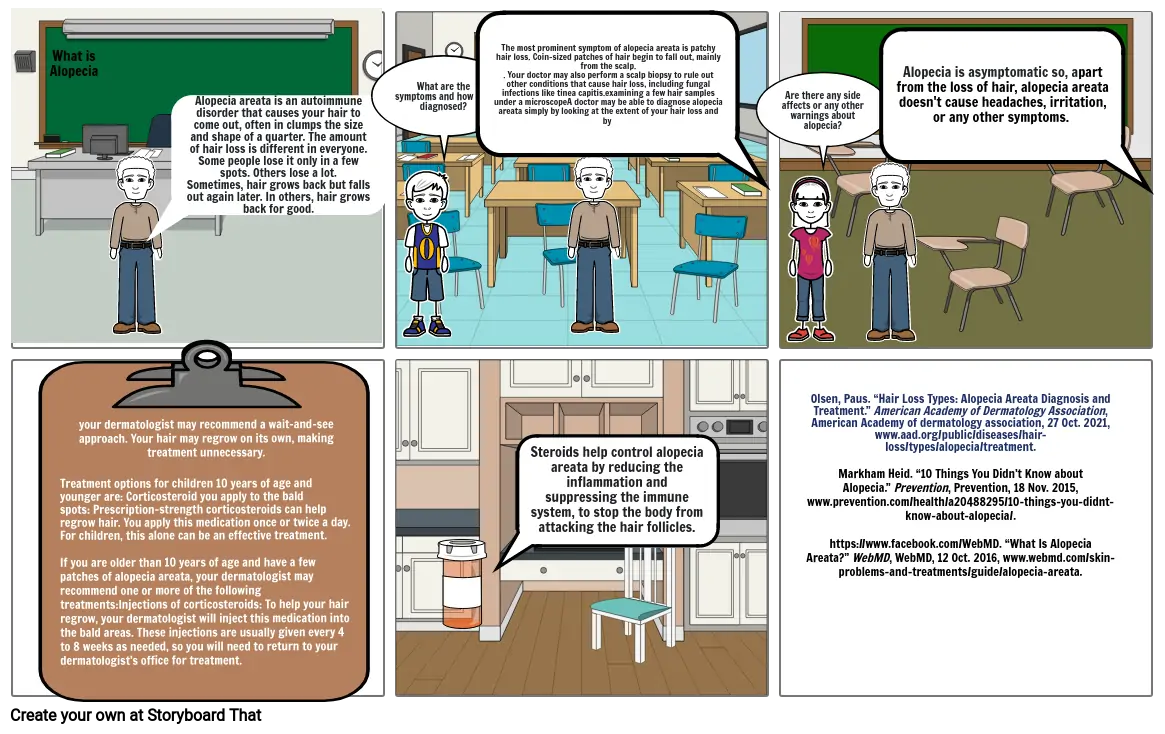Alopecia Areata

Storyboard Text
- What is Alopecia
- Alopecia areata is an autoimmune disorder that causes your hair to come out, often in clumps the size and shape of a quarter. The amount of hair loss is different in everyone. Some people lose it only in a few spots. Others lose a lot. Sometimes, hair grows back but falls out again later. In others, hair grows back for good.
- What are the symptoms and how is it diagnosed?
- Are there any side affects or any other warnings about alopecia?
- The most prominent symptom of alopecia areata is patchy hair loss. Coin-sized patches of hair begin to fall out, mainly from the scalp.. Your doctor may also perform a scalp biopsy to rule out other conditions that cause hair loss, including fungal infections like tinea capitis.examining a few hair samples under a microscopeA doctor may be able to diagnose alopecia areata simply by looking at the extent of your hair loss and by
- Alopecia is asymptomatic so, apart from the loss of hair, alopecia areata doesn't cause headaches, irritation, or any other symptoms.
- your dermatologist may recommend a wait-and-see approach. Your hair may regrow on its own, making treatment unnecessary.Treatment options for children 10 years of age and younger are: Corticosteroid you apply to the bald spots: Prescription-strength corticosteroids can help regrow hair. You apply this medication once or twice a day. For children, this alone can be an effective treatment.If you are older than 10 years of age and have a few patches of alopecia areata, your dermatologist may recommend one or more of the following treatments:Injections of corticosteroids: To help your hair regrow, your dermatologist will inject this medication into the bald areas. These injections are usually given every 4 to 8 weeks as needed, so you will need to return to your dermatologist’s office for treatment.
- Steroids help control alopecia areata by reducing the inflammation and suppressing the immune system, to stop the body from attacking the hair follicles.
- Olsen, Paus. “Hair Loss Types: Alopecia Areata Diagnosis and Treatment.” American Academy of Dermatology Association, American Academy of dermatology association, 27 Oct. 2021, www.aad.org/public/diseases/hair-loss/types/alopecia/treatment.Markham Heid. “10 Things You Didn’t Know about Alopecia.” Prevention, Prevention, 18 Nov. 2015, www.prevention.com/health/a20488295/10-things-you-didnt-know-about-alopecia/.https://www.facebook.com/WebMD. “What Is Alopecia Areata?” WebMD, WebMD, 12 Oct. 2016, www.webmd.com/skin-problems-and-treatments/guide/alopecia-areata.
Over 30 Million Storyboards Created

